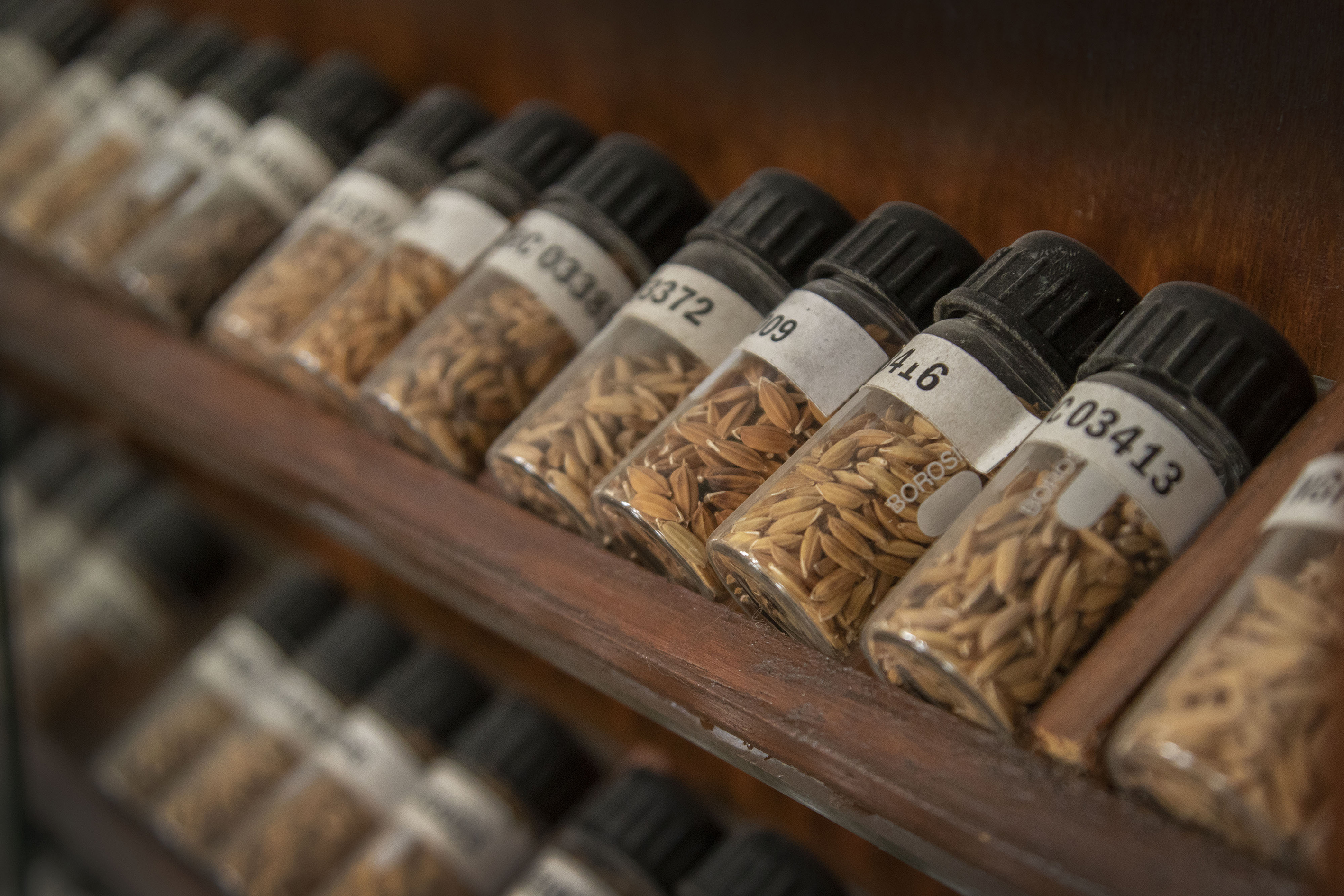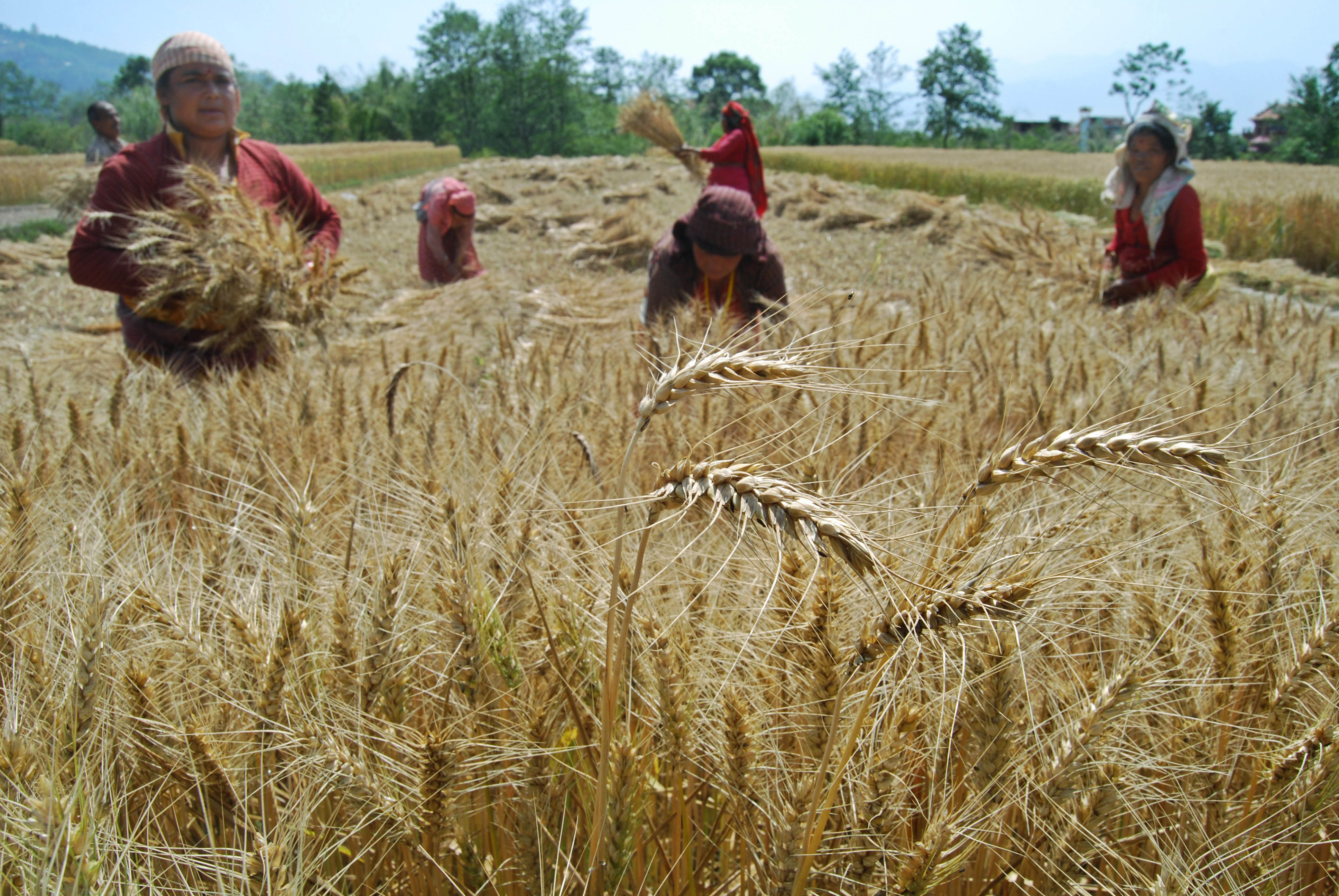Science & Technology
Nepal’s growing reliance on imported hybrid seeds risks devastating consequences
A majority of seeds used by farmers across Nepal for both grains and vegetables come from outside the country, and scientists say that’s not good news.
Tsering Ngodup Lama
Chandra Bahadur Yonjan Tamang remembers the taste and smell of jyapu cauliflower. For decades, this local breed was the only cauliflower that farmers in his village of Bardev grew. Farmers would plant seeds in mid-September and by mid-February, the cauliflower would be ready for harvest.
“When people cooked jyapu cauliflower, it smelled delicious,” said Tamang.
That was at least a decade ago. Now, not a single farmer in the village grows jyapu cauliflowers anymore. All the cauliflower in the village is now grown from seeds manufactured by Nozaki Saishujo Ltd, a Japanese company.
“Hybrid cauliflower seeds only take two months to mature whereas jyapu cauli took six months. The yield is better, too,” said Tamang.
It’s not just local varieties of cauliflower that have been replaced by hybrid varieties from other countries. Most vegetables that the villagers grow come from imported hybrid seeds. And this is not limited to Bardev—it is happening across the country.
Just three decades ago, a majority of Nepali farmers relied on local indigenous seeds. Even until the 90s, Nepal was a seed exporting country. Today, according to agriculture scientists, more than 90 percent of vegetable seeds employed in the country are imported. Nearly 30 percent of maize seeds are imported, and around 15 percent of rice seeds are from other countries.
As the number of vegetables and grains grown from imported hybrid seeds increases every year, scientists warn that this reliance on imports for something as sensitive to food security as seeds could have devastating consequences for the country’s agriculture sector—and for the genetic diversity of indigenous plants.
“A country can never be food secure if it isn't seed secure,” said Madan Rai, seed specialist and agronomist. “Seed security is when farmers in the country have access to quality seeds at the right time and at reasonable prices. It's important that we as a country are self-sufficient on seeds to truly become food secure.”
Although exact data on when imported hybrid seeds were first used in the country is hard to come by, agriculture experts believe that farmers started using them in the early 80s.
“Our findings show that in the 80s, farmers in the districts of Bara and Parsa were planting hybrid maize seeds,” said Dila Ram Bhandari, former chief of the government's Seed Quality Control Centre. “These hybrid maize seeds were most likely imported informally from India via the porous border."
Rice hybrid seeds were first introduced to the country in the late 90s and early 2000s, according to Bhandari, and now, nearly 15 percent of total rice seeds used in the country are imported hybrids. Imported vegetable seeds, he said, were first introduced in the country some 30 years ago.
“Farmers in many countries were already using hybrid seeds decades before Nepali farmers started using them,” said Rai. In neighbouring India, hybrid seeds were introduced as early as the 60s.

What are hybrid seeds?
To understand why farmers in Nepal transitioned to hybrid seeds, understanding why hybrid seeds were created in the first place is crucial.
"After the Second World War, populations in the larger economies of the world started increasing rapidly, but agriculture output in these countries was inadequate to feed the growing population,” said Rai. “To avert food shortages, these countries started focusing on creating high yield, disease-resistant seeds.”
At the forefront of the movement was an American, Norman Borlaug, known as the 'Father of Green Revolution' and winner of the 1970 Nobel Peace Prize for his contributions to drastically increasing the world’s food supply. Borlaug's high-yield dwarf varieties of wheat were introduced to India and Pakistan in the 60s and are credited with helping avert famine in the two countries.
Hybrid varieties are created by selectively cross-breeding two different but related plants. “It is done to develop new varieties with the desired traits, such as uniform shape and colour, higher yield and disease resistance,” said Rai.
The major difference between open-pollinated varieties and hybrid varieties is that seeds from the latter may not produce the same characteristics as the original. “But some hybrid varieties are developed in a way that they cannot technically multiply,” said Tara Bahadur Ghimire, principal scientist and chief of the Seed Science and Technology Division at the Nepal Agriculture Research Centre (NARC). “So farmers have to keep buying hybrid seeds every year, making them dependent on seed companies.”
The population of Nepal in 1980, which was around the same time the first hybrid seeds were used, was 15.01 million. But by 2000, the country's population had reached 23.9 million. “To feed the growing population, the country had to increase agricultural output. But it was impossible to do so by relying solely on local varieties. The most practical way to increase agricultural production was by using hybrid seeds,” said Rai.
Along with the increasing population, rapid urbanisation and skyrocketing land prices have led land for agriculture to shrink. The total land area used for cultivation in the fiscal year 2015/2016 was 2,579,097 hectares, against 2,548,763 hectares in the 2016/2017 fiscal, a decrease of 30,334 hectares. Agro-economists say that in the last 10 years alone, more than 100,000 hectares of arable land have been lost to urbanisation.
With land shrinking, it makes more commercial sense for farmers like Tamang to rely on hybrid seeds. “Crops from hybrid seeds mature sooner than local varieties. This means we can sell them sooner. The return on investment is not only higher but also quicker,” said Tamang.
[Read: Arable land is shrinking, and so is paddy cultivation]
Agriculture experts like Rai explain that the problem is not with hybrid seeds per se but with Nepal’s over-dependence on imported seeds. “Farmers' topmost priority will always be to ensure food security. Their goal will be to have enough food to consume and sell, and hybrid seeds have around 30 percent higher yield than local varieties,” said Bhandari. "So, it's only natural that farmers would choose hybrid seeds over local varieties.”
According to data provided by the Department of Customs, in the fiscal year 2018/2019, Nepal imported 424,333 kgs of vegetable seeds worth Rs 553.08 million and 4.22 million kgs of maize seeds worth Rs 393.16 million.
“Our seed imports have been steadily increasing for many years, which is contributing to Nepal's already ballooning trade deficit,” said Rai. "Imagine if the countries we import our seeds from refuse to send us seed. What will our farmers grow then? What will the nation eat? These things might sound far-fetched, but we all know what happened when India imposed a trade embargo.”
.jpg)
Manifold risks
The risk of depending on imported seeds goes beyond the realms of the country's food and economic security.
“In the context of our country, this dependence presents multi-fold risks," said Yamuna Ghale, a food and agriculture policy analyst. “Many of these imported hybrid seed packets lack even the basic planting information, leaving farmers with no knowledge of how to plant them and the ideal conditions to plant them in.”
A few metres from Tamang's house in Bardev is the village seed shop, where farmers come to procure seeds. The shop sells cucumber, spinach, cauliflower and turnip seeds, but none of the packets has any information on what kind of fertilisers and chemicals should be used; how much water the plant will need, and very crucially, the ideal climatic conditions to grow them in.
“This information is important for farmers to get optimal results from the seeds,” said Ghale. “Even the limited information available is written in languages other than Nepali.”
But in the absence of crucial information, farmers in Bardev said that they have no option but to rely on the same technique they had used to plant local varieties. “We grow imported Japanese hybrid cauliflowers the same way we grew jyapu cauliflowers. Fortunately, they have all grown well. We haven't had any crop failure so far,” said Tamang.
But there have been several incidents of massive crop failure in the past. In 2013, paddy planted in 16 VDCs in Bhaktapur, amounting to 20,000 tonnes and worth Rs 80 million, was destroyed by “neck blast” and “bacterial leaf blight” diseases. Investigations revealed that the farmers had used DY 69--a Chinese hybrid variety--registered and recommended by the Seed Quality Control Centre under the Ministry of Agriculture Development in 2010. Bhandari was assigned to investigate the case, and his findings revealed the extent to which lack of information could hurt farmers.
“The hybrid seed the farmers had used was recommended for the Tarai and Inner Tarai region, not Bhaktapur,” says Bhandari.
In another incident of crop failure, in 2012, maize crops sown on a total 8,000 hectares of land in five districts of Tarai grew corn with no kernels in one-third of the area. The farmers had used X-92, Sandhya and Rajkumar brands of hybrid maize seeds supplied by an Indian company.

Creating Nepal’s own hybrids
Rai, the seed scientist, blames the nation's heavy dependence on imported seeds on the country's political leadership and its lack of will to address the issue.
“In a meeting with Girija Prasad Koirala in 1990, I informed him of the negative ramifications the country will have to deal with for relying heavily on imported seeds. I urged him to take necessary measures,” said Rai. “In the following years, I approached a lot of ministers and told them the same. The political leadership failed to understand that seeds are the source of our existence, and depending on other countries for something as basic as seeds would leave the country very vulnerable.”
NARC, an autonomous organisation set up to conduct agricultural research in the country, was only set up in 1991. But the government, say experts, deprived the organisation of the resources needed to do any significant work sustainably.
“Out of the country's total agriculture budget, only seven percent gets allocated for research. The government has to dedicate at least 15 to 20 percent of the agriculture budget,” said Dil Bahadur Gurung, a member of the National Planning Commission and former executive director of NARC. “We need to focus on strengthening the country's agriculture research system and building the capacity of our scientists and researchers.”
In the nearly 30 years of the organisation's history, it has only been able to develop one hybrid tomato variety and seven different varieties of hybrid maize. Years of governmental neglect has left the country's agriculture research sector in a dismal state. Without the resources required to develop hybrid seeds from indigenous local varieties, NARC has had to rely on the International Maize and Wheat Improvement Center (also known as CIMMYT) to develop its hybrid maize varieties. All the parent lines for the maize hybrid that NARC has developed were acquired from CIMMYT.
“First we get hybrid seeds from CIMMYT and test the seeds here in the country. The organisation then sends us the parent lines of the hybrid seeds that have passed the test. NARC doesn't get charged for the hybrid seeds or the parent lines. Once we have the parent lines, seed multiplication begins in the country,” said Ghimire. “In an ideal situation, we would be using local parent lines to create hybrid varieties. But doing so will take a lot of resources, which we don't have. It will also take many years. So we have no option but to reply on imported parent lines.”
To address the issues plaguing the country’s agriculture sector, in 2013, the Ministry of Agriculture came up with 'National Seed Vision 2013-2025'. The programme’s aim is to increase crop productivity, raise incomes and generate employment opportunities through self-sufficiency, import substitution and export promotion of quality seeds. The programme expects to create 40 hybrids--20 vegetables, 12 maize and eight rice--by 2025. It also envisions that the private sector will create 20 hybrids--10 vegetables, five maize and five rice--by 2025.
“By 2025, the National Seed Vision aims to release 423 open pollinated varieties and 60 hybrid varieties. But currently, the numbers stand at 273 for open pollinated varieties, and eight for hybrid,” said Ghimire.
Agriculture experts, however, say that the numbers are very ambitious, and the targets set are unlikely to be met.
“Hybrid R&D requires a huge amount of money, and NARC doesn’t have the money. The private sector too is very skeptical about investing that much money. It’s easier for private companies to acquire dealership from foreign seed companies and import them into the country than to take on the hassle of setting up R&D in the country,” said Ghale.
But even the few hybrid seeds produced in Nepal face fierce competition from imported seeds manufactured in the highly advanced laboratories of China, Japan and India.
“Seed companies abroad have the infrastructure and human resources to work with seeds at the molecular level, allowing them to create very high-quality hybrid seeds. For us, competing with their quality is difficult,” said Ghimire. “But that said, our hybrid seeds are better than low-quality imported hybrid seeds, which are aplenty in the market.”

Some agro-scientists the Post spoke to said that depending solely on hybrid seeds isn’t good for the soil.
“Hybrid seeds require a lot more nutrients than open-pollinated ones. So farmers have to use a lot of fertilisers, which accelerates the depletion of soil quality,” said Ghimire. “This is one of the long term serious negative impacts of using hybrid seeds.”
Increased use of hybrid seeds will thus drive demand for pesticides and chemical fertilisers, and Nepal, which doesn't manufacture such fertilisers, will end up relying more on imports.
A balance must be struck between hybrid and open-pollinated local varieties, say experts.
“The government should also focus on promoting local varieties for crops wherever possible,” said Ghimire. "Even farmers in the country tend to care more for crops grown using hybrid seeds. But they do not give the same care for crops grown with open-pollinated seeds. We have some improved local varieties that give as much yield as hybrid ones if properly cared for. For example, our Khumal-4 variety of rice, an open-pollinated pure line variety, will give the same yield as hybrid if given proper care.”
The government, say seed experts, needs to brand and promote these local open-pollinated varieties to get farmers to use them.
With easy availability of hybrid seeds, farmers today are not only lessening their use of local open pollinated varieties, they are also not saving any seeds. “Genetic diversity within local varieties is disappearing, and this is a matter of concern. Some of the local vegetables that I grew up eating are no longer available in the market,” said Ghale.
After decades of singular focus on hybrid seeds to increase agricultural productivity, there's a growing demand for crops produced from local varieties. “It's a fact that crops from hybrid seeds don't taste or smell as good as local varieties. Hybrid rice will never match the taste and smell of Pokhreli Jetho Budo, and the demand for local products are seeing an increase,” said Bhandari. “People are willing to pay more for local crops. Once there's demand, there will be supply.”
In the last few years, the country has seen a small but growing demand for local varieties. “Local fruits and vegetables taste and smell better than hybrid crops,” said Bardev farmer Tamang. “The growing demand has made me realise that I should start growing jyapu cauliflower, but no one in the village has the seeds anymore.”
For decades, Rai says, the political leadership lacked the will to do what was necessary to avert the situation the country is in today. But still, he says, it’s not too late.
“With the right policy interventions, we can still turn things around,” said Rai. “But if we continue to refuse to take things seriously, seeds could be used against us as a political weapon, and we will have nothing to defend ourselves with.”
***
What do you think?
Dear reader, we’d like to hear from you. We regularly publish letters to the editor on contemporary issues or direct responses to something the Post has recently published. Please send your letters to [email protected] with "Letter to the Editor" in the subject line. Please include your name, location, and a contact address so one of our editors can reach out to you.




 12.12°C Kathmandu
12.12°C Kathmandu





